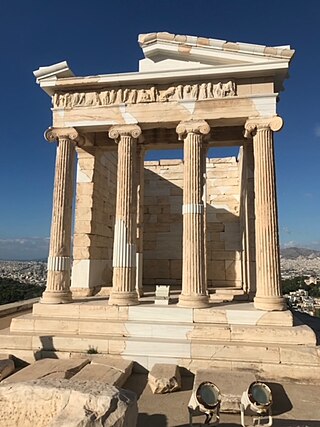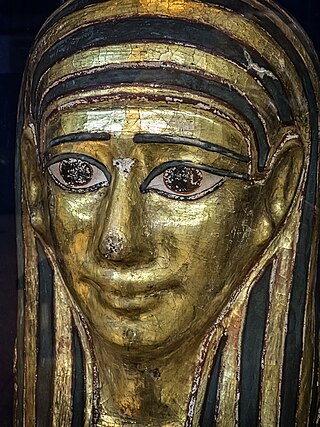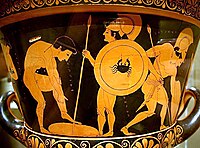Archaeological ethics refers to the moral issues raised through the study of the material past. It is a branch of the philosophy of archaeology. This article will touch on human remains, the preservation and laws protecting remains and cultural items, issues around the globe, as well as preservation and ethnoarchaeolog.

Cultural heritage is the heritage of tangible and intangible heritage assets of a group or society that is inherited from past generations. Not all heritages of past generations are "heritage"; rather, heritage is a product of selection by society.

Repatriation is the return of the cultural property, often referring to ancient or looted art, to their country of origin or former owners.

Archaeological looting in Iraq took place since at least the late 19th century. The chaos following war provided the opportunity to pillage everything that was not nailed down. There were also attempts to protect the sites such as the period between April 9, 2003, when the staff vacated the Iraq Museum and April 15, 2003, when US forces arrived in sufficient numbers to "restore some semblance of order." Some 15,000 cultural artifacts disappeared in that time. Over the years approximately 14,800 were recovered from within and outside Iraq and taken under the protection of the Iraqi government.
Robert Emmanuel Hecht, Jr. was an American antiquities art dealer based in Paris.
American Council for Cultural Policy (ACCP) was a not-for-profit organization formed in 2002 by a group of politically influential antiquities dealers, collectors and lawyers in the United States, with its headquarters in New York and representatives in Washington D.C. The goal of the organization was described by Ashton Hawkins as "informing the public on arts issues." The organization is now defunct and its website (culturalpolicycouncil.org) has been removed from the web. Some of its members now actively take part in Cultural Policy Research Institute.

Looted art has been a consequence of looting during war, natural disaster and riot for centuries. Looting of art, archaeology and other cultural property may be an opportunistic criminal act or may be a more organized case of unlawful or unethical pillage by the victor of a conflict. The term "looted art" reflects bias, and whether particular art has been taken legally or illegally is often the subject of conflicting laws and subjective interpretations of governments and people; use of the term "looted art" in reference to a particular art object implies that the art was taken illegally.

Djenné-Djenno is a UNESCO World Heritage Site located in the Niger River Valley in the country of Mali. Literally translated to "ancient Djenné", it is the original site of both Djenné and Mali and is considered to be among the oldest urbanized centers and the best-known archaeological sites in West Africa.
The Convention on the Protection of the Underwater Cultural Heritage is a treaty that was adopted on 2 November 2001 by the General Conference of the United Nations Educational, Scientific and Cultural Organization (UNESCO). The convention is intended to protect "all traces of human existence having a cultural, historical or archaeological character" which have been under water for over 100 years. This extends to the protection of shipwrecks, sunken cities, prehistoric art work, treasures that may be looted, sacrificial and burial sites, and old ports that cover the oceans' floors. The preservation of underwater cultural heritage is significant as it allows for the retelling of numerous historical events. As part of its duty to conduct scientific research and provide continuous education on the importance of underwater cultural heritage, UNESCO strives to maintain these sites for the enjoyment of current and future generations. The convention may provide a customary framework to help raise awareness and seek to combat the illegal looting and pirating occurring in waters worldwide. As an international body, member states of the convention agree to work towards the preservation of sunken cultural property within their jurisdiction and the high seas.

The Quimbaya (/kɪmbaɪa/) were a small indigenous group in present-day Colombia noted for their gold work characterized by technical accuracy and detailed designs. The majority of the gold work is made in tumbaga alloy, with 30% copper, which colours the pieces.
The Association for Research into Crimes against Art (ARCA) is a nongovernmental civil society organisation (CSO) that conducts scholarly research and training within the discipline of combatting cultural property crime. Established in 2009 with the aim of exploring the gaps in the international legal framework which addresses art and antiquities crimes. ARCA was founded by Dr. Noah Charney, an art and art crime historian, as well as a published author.

The Carabinieri Command for the Protection of Cultural Heritage, better known as the Carabinieri T.P.C., is the branch of the Italian Carabinieri responsible for combatting art and antiquities crimes and is viewed as an experienced and efficient task force.

The UNESCO 1970 Convention on the Means of Prohibiting and Preventing the Illicit Import, Export and Transfer of Ownership of Cultural Property is an international treaty to combat the illegal trade in cultural items. It was signed on 14 November 1970 and came into effect on 24 April 1972. As of February 2024, 143 states have ratified the convention.

Quimbaya artifacts refer to a range of primarily ceramic and gold objects surviving from the Quimbaya civilisation, one of many pre-Columbian cultures of Colombia inhabiting the Middle Cauca River valley and southern Antioquian region of modern-day Colombia. The artifacts are believed to have originated during the Classical Quimbaya period 500 BC–600 AD.
The Cultural Heritage Center of the American Bureau of Educational and Cultural Affairs specializes in the protection and preservation of the world's ancient and historic monuments and archeological sites.

Geneva Freeport is a warehouse complex in Geneva, Switzerland, for the storage of art and other valuables and collectibles. It is the oldest and largest freeport facility, and the one with the most artworks, with 40% of its collection being art with an estimated value of US$100 billion.

The conservation and restoration of archaeological sites is the collaborative effort between archaeologists, conservators, and visitors to preserve an archaeological site, and if deemed appropriate, to restore it to its previous state. Considerations about aesthetic, historic, scientific, religious, symbolic, educational, economic, and ecological values all need to be assessed prior to deciding the methods of conservation or needs for restoration. The process of archaeology is essentially destructive, as excavation permanently changes the nature and context of the site and the associated information. Therefore, archaeologists and conservators have an ethical responsibility to care for and conserve the sites they put at risk.

The Convention on Cultural Property Implementation Act is a United States Act of Congress that became federal law in 1983. The CCPIA implemented the 1970 UNESCO Convention on the Means of Prohibiting and Preventing the Illicit Import, Export and Transfer of Ownership of Cultural Property. It restricts the importation of some archaeological and ethnological materials into the United States from other State Parties to the Convention.

The coffin of Nedjemankh is a gilded ancient Egyptian coffin from the late Ptolemaic Period. It once encased the mummy of Nedjemankh, a priest of the ram-god Heryshaf. The coffin was purchased by the New York City Metropolitan Museum of Art in July 2017 to be the centerpiece of an exhibition entitled "Nedjemankh and His Gilded Coffin." The Metropolitan Museum of Art repatriated Nedjemankh and his coffin to Egypt in 2019, before the scheduled closure of the exhibition.

The Pennsylvania Declaration was a statement of ethics issued by the University of Pennsylvania Museum of Archaeology and Anthropology on April 1, 1970. It affirmed that the Penn Museum would no longer acquire objects that lacked provenance or collection histories. The declaration aimed to distinguish the Penn Museum's collection practices from illegal antiquity trading while maintaining trust with countries where the university engaged in field research. This declaration marked the first time that a museum had taken formal steps to guarantee the ethical acquisition of materials and to deter looting and illicit antiquities trading. Froelich Rainey, director of the Penn Museum, presented the declaration at the meeting of the United Nations Educational, Scientific, and Cultural Organization (UNESCO), in conjunction with the issue of its treaty known as the 1970 Convention on the Means of Prohibiting and Preventing the Illicit Import, Export and Transfer of Ownership of Cultural Property.














